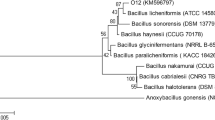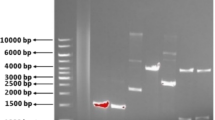Abstract
Objective
To examine the potential for applications of TthLAC, a monomeric (~ 53 kDa) laccase encoded by the genome of Thermus thermophilus (strain HB 27) which can be produced at low cost in Escherichia coli.
Result
Functional, thermostable and mildly alkalophilic TthLAC of high purity (> 90%) was produced through simple heating of suspended (TthLAC overexpressing) E.coli cells at 65 °C. For reactions of short duration (< 1 h) the temperature for optimal activity is ~ 90 °C. However, TthLAC undergoes slow partial unfolding and thermal inactivation above 65 °C, making it unsuitable for long incubations above this temperature. With different substrates, optimal function was observed from pH 6 to 8. With the substrate, ABTS, catalytic efficiency (K m) and maximum velocity (Vmax) at 60 °C and pH 6.0 were determined to be 2.4 × 103 µM and 0.04 × 103 µM/min respectively. Ultra-pure, affinity-purified TthLAC was used to confirm and characterize the enzyme’s ability to oxidize known (laccase) substrates such as ABTS, syringaldazine and 4-fluoro-2-methylphenol. TthLAC decoloured up to six different industrial dyes, with or without the use of redox mediators such as ABTS.
Conclusions
Unlike versatile laccases from most other sources, which tend to be thermolabile as well as acidophilic, TthLAC is a versatile, thermostable, mildly alkalophilic laccase which can be produced at low cost in E.coli for various redox applications.





Similar content being viewed by others
References
Alexandre G, Zhulin IB (2000) Laccases are widespread in bacteria. Trends Biotechnol 18:41–42
Bourbonnais R, Paice MG (1996) Enzymatic delignification of Kraft pulp using laccase and a mediator. Tech Assoc Pulp Pap Ind J 79:199–204
Deckert G, Warren PV, Gaasterland T, Young WG, Lenox AL, Graham DE, Overbeek R, Snead MA, Keller M, Aujay M, Huber R, Feldman RA, Short JM, Olson GJ, Swanson RV (1998) The complete genome of the hyperthermophilic bacterium Aquifex aeolicus. Nature 392:353–358
Duy C, Fitter J (2005) Thermostability of irreversible unfolding α-amylases analyzed by unfolding kinetics. J Biol Chem 280:37360–37365
Margot J, Bennati-Granier C, Maillard J, Blánquez P, Barry DA, Holliger C (2013) Bacterial versus fungal laccase: potential for micropollutant degradation. AMB Exp 3:63–77
Martins LO, Soares CM, Pereira MM, Teixeira M, Costa T, Jones GH, Henriques AO (2002) Molecular and biochemical characterization of a highly stable bacterial laccase that occurs as a structural component of the Bacillus subtilis endospore coat. J Biol Chem 277:18849–18859
Miyazaki K (2005) A hyperthermophilic laccase from Thermus thermophilus HB 27. Extremophiles 6:415–425
Nyanhongo GS, Gomes J, G¨ubitz GM, Zvauya R, Read J, Steiner W (2002) Decolorization of textile dyes by laccase from a newly isolated strain of Trametes modesta. Water Res 36:1449–1456
Reiss R, Ihssen J, Thöny-Meyer L (2011) Bacillus pumilus laccase: a heat stable enzyme with a wide substrate spectrum. BMC Biotechnol 11:9–20
Roberts SA, Weichsel A, Grass G, Hazzard JT, Tollin G, Rensing C, Montfort WR (2002) Crystal structure and electron transfer kinetics of CueO, a multicopper oxidase required for copper homeostasis in Escherichia coli. Proc Natl Acad Sci USA 99:2766–2771
Serrano-Posada H, Centeno-Leija S, Patricia Rojas-Trejo S (2015) X-ray-induced catalytic active-site reduction of multicopper oxidase: structural insights into the proton-relay mechanism and O2-reduction states. Acta Cryst D 71:2396–2411
Sharma P, Goel R, Capalash N (2007) Bacterial laccases. World J Microbiol Biotechnol 23:823–832
Sherif M, Waung D, Korbec B, Mavisakalyan V, Flick R, Brown G, Abou-Zaid M, Yakunin AF, Master ER (2013) Biochemical studies of the multicopper oxidase (small laccase) from Streptomyces coelicolor using bioactive phytochemicals and site-directed mutagenesis. Microb Biotechnol 6:588–597
Wong L, Yu J (1999) Laccase-catalyzed decolorization of synthetic dyes. Water Res 33:3512–3520
Zhang M, Wu F, Wei Z, Xiao Y, Weimin Gong (2006) Characterization and decolorization ability of a laccase from Panus rudis. Enzym Microb Technol 39:92–97
Acknowledgements
AK and NK would like to thank the Centre of Excellence in Protein Science, Design and Engineering (CPSDE) funded by the Ministry of Human Resource Development (MHRD), Government of India, for financial support.
Supporting information
Supplementary Figure 1—(A) Amplification of the gene encoding TthLAC along with restriction sites and 6xHis affinity tag (1.3 kb). (B) Restriction-digestion based verification of the presence of the clone (gene) in the pET 28a Vector (size 5369 bp) through release of the insert of 1.3 kb upon digestion with NdeI and EcoRI.
Supplementary Figure 2—Fragmentation of a tryptic peptide of mass 1936 Da using ESI-TOF MS-MS mass spectrometery and analysis by the Biolynx tool of the Mass Lynx software of the WATERS G2SHDMS.
Supplementary Figure 3—(A) Far-UV circular dichroic (CD) spectrum of TthLAC. (B) Chromatographic profile of of TthLAC eluting from a Superdex-200 gel filtration column. (C) SDS-PAGE showing TthLAC incubated with glutaraldehyde. (D) Dynamic light scattering-derived hydrodynamic diameter data for TthLAC.
Supplementary Figure 4—Tmid values for the partial unfolding transitions of TthLAC.
Supplementary Figure 5—Denaturant-induced unfolding of TthLAC.
Supplementary Figure 6—(A) Oxidization of ABTS into a green product by TthLAC. (B) Variation of TthLAC activity with pH. (C) Absorption spectrum of ABTS after enzymatic treatment at pH 6.
Author information
Authors and Affiliations
Corresponding author
Electronic supplementary material
Below is the link to the electronic supplementary material.
Rights and permissions
About this article
Cite this article
Kumari, A., Kishor, N. & Guptasarma, P. Characterization of a mildly alkalophilic and thermostable recombinant Thermus thermophilus laccase with applications in decolourization of dyes. Biotechnol Lett 40, 285–295 (2018). https://doi.org/10.1007/s10529-017-2461-8
Received:
Accepted:
Published:
Issue Date:
DOI: https://doi.org/10.1007/s10529-017-2461-8




